Twentieth Century Currents:
"Race" and "Nation," across the World Wars
Part One: "Race"
(part one presented on March 17, 1999
at North Georgia College and State University)
Introduction
As we approach the twenty-first century, besides hearing about the
Y2K problem, we have begun to hear a few reflections on the century as a whole. Recently a
group of veteran journalists and historians voted on the century's top 100 news stories to
be included in a new interactive news museum, a "newseum," near Washington, D.C.1 The leading news event of the century is the
bombing of Hiroshima, the second is Neil Armstrong's walk on the moon, and the third is
Japan's bombing of Pearl Harbor.
Some day, forty or fifty years from now, our children or
grandchildren may enter this newseum and stroll along the multi-media displays, reflecting
on the big events of the distant twentieth century.
- The bombing of Hiroshima will certainly grab their attention.
100,000 died in the first explosion of a nuclear weapon to, "end the war quickly and
save American lives," if that is still the most common explanation given in American
schools." 2
- Walking on the moon. They might still say, "cool!,"
before moving on.
- Pearl Harbor: the Japanese sneak attack. Some might think,
"That wasn't fair!" Maybe they will make some kind of connection between Pearl
Harbour and the American bombing of Hiroshima as retribution. Or maybe they will skip over
Pearl Harbor altogether. After all, it was just a military attack on an American base on
territory seized by the American marines forty-seven years earlier. Hawaii only became a
state in 1958.
Is that how best to remember the history of the twentieth century,
as a series of startling events? Maybe it is the best way. Each event offers simple moral
lessons and inspirations. Some students, though, will want to know more. Why did Pearl
Harbor offend Americans so much and drive them eventually to drop a nuclear bomb on a
largely civilian population. They might discover the debate over what the Americans did
know about Japanese military plans, including the bombing of Pearl Harbour.3 The students might laugh when they find out
that among the American intelligence at the time, many thought the Japanese incapable of
building reliable air craft or even flying at night because of defects in their race. The
British and even the Germans were baffled when the Japanese sunk British ships in the
Philippines and proceeded to take over most of the South Pacific islands early in the war.
Some British military intelligence thought the Germans must have flown the planes.4
Currents
If the curious student continued to probe further into the
twentieth century, he or she might find that the century was largely driven by currents of
racial theories and related ranking of the peoples of the world according to skin color,
eye shape, and ethnicity. Forty or fifty years from now, this should be hard for a young
person to believe (or maybe not!).
Taking a longer perspective, a student in the twenty-first century
might see the twentieth century from the backdrop of the 18th and 19th centuries, when the
world economy finally began to catch up with the Liberal eighteenth century Nationalist
ideals of the French and American revolutions -- the Rights of Man and representation of
all peoples through a democratic form of government. The Industrial Revolution, the
Colonial legacy and related pseudo-scientific theories of racial evolution in the
late-nineteenth and early twentieth century may have merely eclipsed those ideals.5
At the turn of the twentieth century, those nations who had
managed to industrialize (Britain, Germany, France, Belgium, the United States, Russia,
and Japan), raced to capture resources in foreign non-industrialized lands. Most did not
consider the justice of injustice of imperialism because most believed thought that those
with technology had a prerogative to dominate the weak as a natural process of evolution.
In part protect their colonial gains they made in the "Great Game" of
imperialism, the players fought the Great War, the First World War. Ironically, they had
to even enlisted the help of subject peoples of their colonies, promising them
self-determination after victory. These ideals proved premature, however, as the failure
of Wilson's ideals in the Fourteen Points and the Japanese proposal for a racial equality
clause proved. After the war, the industrialized nations continued on their same paths of
imperialism to secure as many resources for their piece of the world economy as possible.
The Great Depression only accelerated the struggle for more resources.
Industrialized nations continued trying to prove their prominence
among the world's races and nations. The national machinery of government-controlled media
and public schools, perfected during the First World War, cultivated national myths and
ugly stereotypes of the Other as the world headed for the Second World War.
A collection of images by John W. Dower (pp.181-200), from media
sources in Japan and the United States during the Second World War show examples of
national propaganda, and how national policy reflected misapplied Darwinian theories and
racial-national mythologies.
The Japanese View
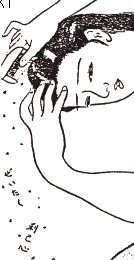 A.
Throughout the 14 year war in Japan beginning with China in 1931, the Japanese government
used the public schools and the media, to appeal to the public to "purify"
themselves and realize the true heart of the Japanese, or the Yamato, as they referred to
their collective 2600 year old history. This cartoon is titled "Purging One's Head of
Anglo-Americanism:" Get rid of the dandruff encrusting your head!" The scurf
being combed out is identified as extravagance, selfishness, hedonism, liberalism,
materialism, money worship, individualism, and Anglo American ideas. For much of the
twentieth century, theories of Modernization, including Marxist theory, saw human progress
exclusively following British and American models of industrialization. full image
A.
Throughout the 14 year war in Japan beginning with China in 1931, the Japanese government
used the public schools and the media, to appeal to the public to "purify"
themselves and realize the true heart of the Japanese, or the Yamato, as they referred to
their collective 2600 year old history. This cartoon is titled "Purging One's Head of
Anglo-Americanism:" Get rid of the dandruff encrusting your head!" The scurf
being combed out is identified as extravagance, selfishness, hedonism, liberalism,
materialism, money worship, individualism, and Anglo American ideas. For much of the
twentieth century, theories of Modernization, including Marxist theory, saw human progress
exclusively following British and American models of industrialization. full image
B. In the next three images, the
leaders of America, Britain, China, and the Dutch (Holland), the A,B,C,D leaders
(Roosevelt for America, Churchill, Chiang Kai-shek, and Holland as a wooden shoe are
revealed in various forms exposing the contradictions in their foreign policy, etc. While
Britain, the U.S., and France preached freedom and democracy, they controlled many
non-industrial parts of the world militarily, and imposed unfair immigration quotas on
non-Caucasian races deemed undesirable.
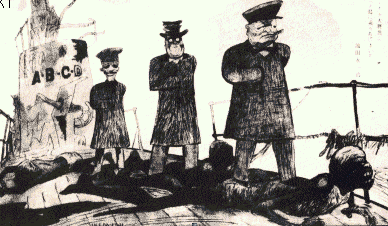
- In the first image from January 1942, the purifying sun of Japanese
glory dispels the ABCD powers. America and Britain are thugs (the crown of Jewish --
"J" -- plutocracy is falling from America's head). China is a sprawling figure
with Chiang Kai-shek's face -- and a stubby tail, a bestial mark often attached to the
Nationalist Chinese. All that remains of the Dutch is a wooden shoe.
- In the next (mid 1942) image, the Allied leaders are Napoleonic
megalomaniacs, trampling on the oppressed (and typically dark) natives of Asia underfoot.
- In the third image (January 1942), titled "Horses Legs,
Badger's Tail," the cartoonist uses folk idioms for exposing deceptive appearances to
the outbreak of the war. Japan's planes have revealed that the pious Churchill really has
the hindquarters of the cunning badger and is clothed in death, while Padre Roosevelt has
a horse's backside (like the English "cloven hoof") and a crucifix for a dagger,
and his real clothing is the almighty dollar. all of the
images
C. The next image is a parody of
Millet's famous painting, "The Angelus," Roosevelt and Churchill are the farmer
and his wife, chained together above their helpless offspring Chiang Kai-Shek at their
feet as they pray against a field of slaughtered bodies. A flag of surrender hangs from
the pitchfork. In the same theme, the following comic strip describes a defeated Chiang
being aided by Roosevelt and Churchill. 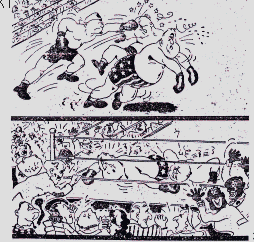 In the right hand bottom corner of the last
image, two black men are elated with Japan's knockout victory over Roosevelt and
Churchill. There was some support for Japan among people of color in America during the
initial phases of the war. Early in the war, Japan tried with some success to cultivate
ties with black groups in the U.S., including the Muslim League (all of the images). A recent study of
African-American attitudes during the war concludes that over fifty percent of Blacks
believed that Japanese rule would be no worse than the white rule at the time..6
In the right hand bottom corner of the last
image, two black men are elated with Japan's knockout victory over Roosevelt and
Churchill. There was some support for Japan among people of color in America during the
initial phases of the war. Early in the war, Japan tried with some success to cultivate
ties with black groups in the U.S., including the Muslim League (all of the images). A recent study of
African-American attitudes during the war concludes that over fifty percent of Blacks
believed that Japanese rule would be no worse than the white rule at the time..6
 D. Here's a parody (January 1942) of the statue of
liberty, titled the "Grieving Statue of Liberty." Roosevelt, waving the slogan
"democracy" while holding the club of "dictatorship,"appears in the
classic guise of a demon. America's decadence is represented by the the figures on
Liberty's crown: the carousing "anti-war" sailor; the fettered figure of
"military action;" the strident worker waving a "strike" placard; and
the clownish "Jew," inflating the balloon of profits disguised as the American
flag. The "2601" above the artist's signature is the year (1941) in the new
nationalistic calendar adopted by the Japanese, based on the divine origins of the
imperial line. full image
D. Here's a parody (January 1942) of the statue of
liberty, titled the "Grieving Statue of Liberty." Roosevelt, waving the slogan
"democracy" while holding the club of "dictatorship,"appears in the
classic guise of a demon. America's decadence is represented by the the figures on
Liberty's crown: the carousing "anti-war" sailor; the fettered figure of
"military action;" the strident worker waving a "strike" placard; and
the clownish "Jew," inflating the balloon of profits disguised as the American
flag. The "2601" above the artist's signature is the year (1941) in the new
nationalistic calendar adopted by the Japanese, based on the divine origins of the
imperial line. full image
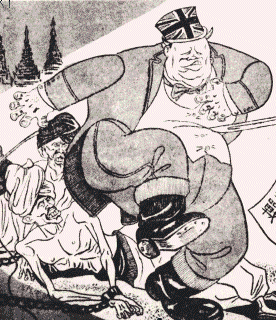 E.
The Japanese used propaganda against the Anglo-American oppressors in
India and Southeast Asia, but the alternative of Japanese control over these regions was
no no less condescending toward the native peoples. Small horns protrude from under
Churchill's hat. The title reads, "Now is the time to rise!!" Greater East Asia
Holy War. In the next image, another white hand reaches down to the obliged dark skinned
native as a Dutch girl runs away in the distance. The Co-Prosperity Sphere was supposed to
show the moral superiority of the Japanese as the true leaders of the region. The
Japanese, however had no higher ideal of the Rights of Man than the Western nations they
sought to replace. all of the images
E.
The Japanese used propaganda against the Anglo-American oppressors in
India and Southeast Asia, but the alternative of Japanese control over these regions was
no no less condescending toward the native peoples. Small horns protrude from under
Churchill's hat. The title reads, "Now is the time to rise!!" Greater East Asia
Holy War. In the next image, another white hand reaches down to the obliged dark skinned
native as a Dutch girl runs away in the distance. The Co-Prosperity Sphere was supposed to
show the moral superiority of the Japanese as the true leaders of the region. The
Japanese, however had no higher ideal of the Rights of Man than the Western nations they
sought to replace. all of the images
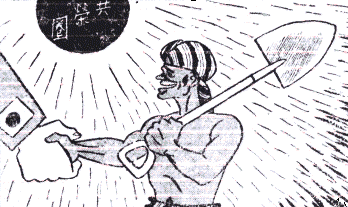
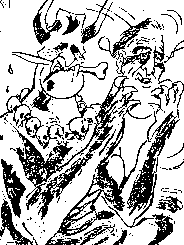 F. Toward the end of
the war, Japanese propaganda portraying American and British atrocities increased to
prepare citizens for the battle on the homefront. In the last image the famous warrior,
the peach boy (MOMOTARO), is summoned to fight the Western devils. all of the images
F. Toward the end of
the war, Japanese propaganda portraying American and British atrocities increased to
prepare citizens for the battle on the homefront. In the last image the famous warrior,
the peach boy (MOMOTARO), is summoned to fight the Western devils. all of the images
The U.S. View
On the other side of the ocean, images in the U.S. media reflect
American outrage that an Asian people could threaten American Manifest Destiny. In 1941,
Hawaii was an island held militarily by the U.S., and it had a larger Asian and Hawaiian
population than Caucasian one. The three Japanese language newspapers in Honolulu during
the war ran articles favorable to the Japan's initial victories during the war and many
Japanese returned to Japan to fight. After the war the survivors returned to Hawaii and
were quickly reassimilated into the community.
A. Dower comments on a cartoon published three
days after the bombing of Pearl Harbor:
. . . it symbolized well how the surprise attack became an
indelible symbol of Japanese treachery in the United States, and inspired immediate
commitment to a vengeful war without mercy. Japanese military planners, obsessed with
operational issues and misled by disdainful stereotypes of Americans as decadent and
egocentric, gave virtually no thought to the psychological consequences of their decision
to attack the U.S. fleet". image
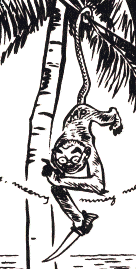
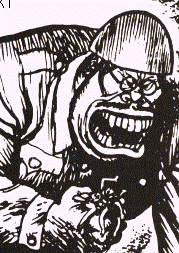 B.
Before the attack, the Japanese were represented as lesser men, or
monkeys. After the attack and the initial Japanese victories in the South Pacific, the
"Yellow Peril" image becomes popular and the monkey turns into a King Kong like
image representing the "Jap Hordes. all of the
images
B.
Before the attack, the Japanese were represented as lesser men, or
monkeys. After the attack and the initial Japanese victories in the South Pacific, the
"Yellow Peril" image becomes popular and the monkey turns into a King Kong like
image representing the "Jap Hordes. all of the
images
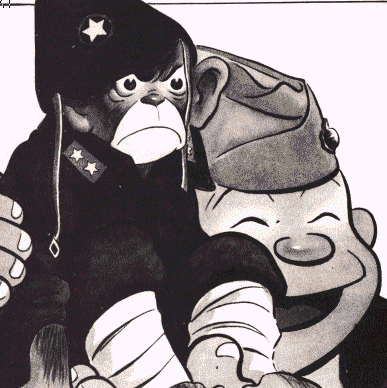 C. In this series of images, one can see the progression of treacherous images
from monkeys to vermin, and finally the transformation during the war to a charming pet.
In the first image, Japan's atrocities in the Philippines are attributed to mimicking
Germany's atrocities in Czechoslovakia. all of the
images
C. In this series of images, one can see the progression of treacherous images
from monkeys to vermin, and finally the transformation during the war to a charming pet.
In the first image, Japan's atrocities in the Philippines are attributed to mimicking
Germany's atrocities in Czechoslovakia. all of the
images
D. A significant transformation
occurred during the war in Western views of the Other, from racial stereotypes based on
pseudo-scientific Darwinian theories. During the war and into the post-war period,
theories regarding the Japanese changed from being deficient racially to being misguided
culturally. Ruth Benedict and others in the field of Anthropology and Psychology peoples
were different not because of racial types, but because of cultural and institutional
development. The Japanese were moving toward modern civilization at a slower pace and,
under appropriate guidance from the west, could move their even faster. full image
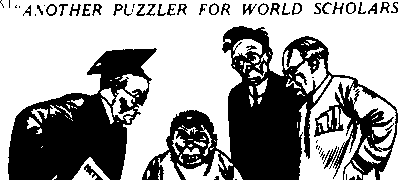
Such images and stereotypes of the Other (racial
and ethnic) during wartime can not look too dissimilar from the Serbian attitudes toward
ethnic Albanians in Kosovo. Unequal immigration policy prejudiced against Asian countries,
segregation policies against African- Americans throughout most of the century, repression
of people because of their political beliefs during the First World War, and internment of
ethnic groups during the First and Second World Wars, would make Milosovic feel at home,
and might make our current NATO campaigns appear a little hypocritical to the cynical
observer.7
Conclusion
One should not be too cynical about the status of American human
rights at the end of the twentieth century, however. The First and Second World Wars and
the related wars in Korea and Vietnam, and the propaganda during wartime -- that America
was fighting for national self-determination, human rights and democracy -- showed
contradictions in American domestic and foreign policy which, consequently, stimulated
popular movements for social and legal reconciliation. The Civil Rights movement in
America, and movements for human rights and self-determination formed the basis of the new
United Nations. Segregation between white and black soldiers through the Second World War
was eliminated in the post-war period in the military and in society at large. In Western
academia, anthropologists began speaking of world cultures rather than races.
And with the disrepute of social and national Darwinism and the related Modernization
theory, even the Western notion of world history and modernity came to include other
narratives besides the traditional Euro-centric one which had dominated institutions of
public education throughout its century-long history. The tragic events of the First and
Second World Wars put an imperative on this change. Taken out of the context of this flow
of history and our very different view of race in the 1940, the bombing of Pearl Harbor
and its corollary, Hiroshima, would probably not have occurred. One could also ask the
question whether the Genocide of Jews in Eastern Europe would have occurred. Certainly,
racial, now more commonly called, ethnic prejudice, still occurs, but at least it appears
to be less of a catalyst in world history than it was across the First and Second World
War.
The significance of "nation" as well has seen great
change over the course of the century. While it was a benign political term, used by the
new middle class in the eighteenth and nineteenth centuries, nation has become a charged
term denote a wide range of meaning -- from liberal democracy to fascism. Campaigns of
exclusionary-nationalism, led by government-controlled forms of propaganda, mass media and
public education, continue to create and/or perpetuate irreconcilable views of the Other,
as racism did in America and Japan during the first half of the twentieth century. The
result has been increasing debate among historians regarding the changing significance of
nationalism. This is the subject of part two, "Nation"

Part 2 / Teaching the
Wars / Research
Endnotes
- Although they do not mention the names or numbers
of the veteran journalist and historians surveyed, the project is directed by the
non-profit Freedom Forum organization and sponsored by USA Weekend at
http://www.newseum.org/century/100stories/100index.htm (view the page in a new window here.) You
can also vote on the top news stories of the century from this site. back
to text
- This was the only explanation I was given as a
middle and high school student in Dunwoody, Georgia (1976-1983). There are more complex
methods of teaching about the bombing used in many schools that I surveyed as part of my
research in this class. They are reviewed in another paper currently being written,
titled, "Teaching the World Wars." back to text.
- Try to disprove the argument that President
Roosevelt was well aware of Japan's plans at the site "Pearl Harbor, Mother of all
Controversies," at http://www.clinton.net/~mewilley/pearl.html (view the page in a
new window here). back to text
- John W. Dower's reviews these and more
startling observations in his book, War Without Mercy (Pantheon: 1986) back to text.
- A general argument in the shift in thinking about
race across the World Wars can be found in Elazar Barkan's The Retreat of Scientific
Racism: Changing Concepts of Race in Britain and the United States Between the World Wars
(Cambridge, 1992). The syllabi and bibliography for a course called, "The Politics of
Race," taught at the University of Warwick can be found at
http://members.tripod.com/~rlekhi/UKlectures.html (view the page in a new window here). An
explanation of Victorian racism can be found on the Victorian web site
http://www.stg.brown.edu/projects/hypertext/landow/victorian/race/rc5.html (open it in a
new window here).
back to text.
- African American Views of the Japanese:
Solidarity or Sedition? (Suny Series, Global Conflict and Peace Education), by
Reginald Kearney and Betty Reardon (State University of New York Press: 1998). back to text
- David M. Kennedy, in Over Here: The First
World War and American Society, (Oxford, 1980), documents the repression of dissidents
in America during the First World War. During the Second World War, human rights
violations are evidenced in the internment of Japanese, Germans, and Italian-Americans in
camps. Jeanne Wakatsuki Houston's Farewell to Manzanar, (Bantam, 1973) documents
well the internment of a Japanese-American family in California. back
to text

Part 2 / Teaching
the Wars / Research
 A.
Throughout the 14 year war in Japan beginning with China in 1931, the Japanese government
used the public schools and the media, to appeal to the public to "purify"
themselves and realize the true heart of the Japanese, or the Yamato, as they referred to
their collective 2600 year old history. This cartoon is titled "Purging One's Head of
Anglo-Americanism:" Get rid of the dandruff encrusting your head!" The scurf
being combed out is identified as extravagance, selfishness, hedonism, liberalism,
materialism, money worship, individualism, and Anglo American ideas. For much of the
twentieth century, theories of Modernization, including Marxist theory, saw human progress
exclusively following British and American models of industrialization. full image
A.
Throughout the 14 year war in Japan beginning with China in 1931, the Japanese government
used the public schools and the media, to appeal to the public to "purify"
themselves and realize the true heart of the Japanese, or the Yamato, as they referred to
their collective 2600 year old history. This cartoon is titled "Purging One's Head of
Anglo-Americanism:" Get rid of the dandruff encrusting your head!" The scurf
being combed out is identified as extravagance, selfishness, hedonism, liberalism,
materialism, money worship, individualism, and Anglo American ideas. For much of the
twentieth century, theories of Modernization, including Marxist theory, saw human progress
exclusively following British and American models of industrialization. full image
 In the right hand bottom corner of the last
image, two black men are elated with Japan's knockout victory over Roosevelt and
Churchill. There was some support for Japan among people of color in America during the
initial phases of the war. Early in the war, Japan tried with some success to cultivate
ties with black groups in the U.S., including the Muslim League (
In the right hand bottom corner of the last
image, two black men are elated with Japan's knockout victory over Roosevelt and
Churchill. There was some support for Japan among people of color in America during the
initial phases of the war. Early in the war, Japan tried with some success to cultivate
ties with black groups in the U.S., including the Muslim League ( D. Here's a parody (January 1942) of the statue of
liberty, titled the "Grieving Statue of Liberty." Roosevelt, waving the slogan
"democracy" while holding the club of "dictatorship,"appears in the
classic guise of a demon. America's decadence is represented by the the figures on
Liberty's crown: the carousing "anti-war" sailor; the fettered figure of
"military action;" the strident worker waving a "strike" placard; and
the clownish "Jew," inflating the balloon of profits disguised as the American
flag. The "2601" above the artist's signature is the year (1941) in the new
nationalistic calendar adopted by the Japanese, based on the divine origins of the
imperial line.
D. Here's a parody (January 1942) of the statue of
liberty, titled the "Grieving Statue of Liberty." Roosevelt, waving the slogan
"democracy" while holding the club of "dictatorship,"appears in the
classic guise of a demon. America's decadence is represented by the the figures on
Liberty's crown: the carousing "anti-war" sailor; the fettered figure of
"military action;" the strident worker waving a "strike" placard; and
the clownish "Jew," inflating the balloon of profits disguised as the American
flag. The "2601" above the artist's signature is the year (1941) in the new
nationalistic calendar adopted by the Japanese, based on the divine origins of the
imperial line.  E.
E.

 F.
F. 
 B.
B.
 C.
C. 